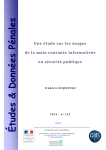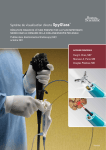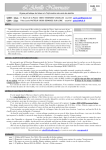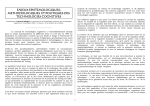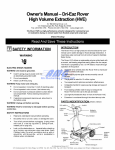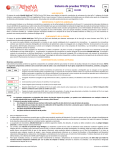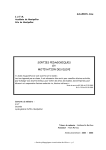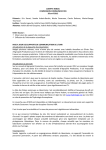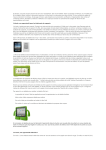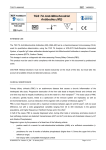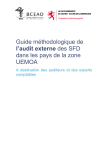Download TGS TA LKM-1 - Technogenetics
Transcript
TGS TA LKM-1 REF REF YA500232 YA500232 TGS TA LKM-1 INSTRUCTIONS FOR USE 50 EN English INTENDED USE The TGS TA LKM-1 (Liver Kidney Microsomes type 1) test is a chemiluminescent immunoassay (CLIA) used for quantitative determination, using the TGS TA Analyzer or IDS-iSYS Multi-Discipline Automated System, of specific IgG class antibodies directed against Liver Kidney Microsomes type 1 in samples of human serum or plasma (EDTA, Sodium Citrate). This dosage is used as a diagnostic aid when assessing type 2 Autoimmune Hepatitis (EAI or AIH) infections. This product must be used in strict compliance with the instructions given in this document by professional users. CAUTION: Medical decisions must not be based exclusively on the result of this test, but must take into account all available clinical and laboratory data as a whole. CLINICAL SIGNIFICANCE Autoimmune Hepatitis (AIH) is a chronic inflammation of the liver of unknown origin, in which immune 1 tolerance to hepatocytes is lost . The disease is detected by the presence of a number of characteristic alterations from the histological point of view, when blood tests show the presence of gamma globulins and 2 3 antibodies . The disease is found mainly in females, both of paediatric and adult ages . It is an autoimmune process and therefore is associated, sometimes, with other autoimmune disorders such as ulcerative colitis 4 5 and Graves’ Disease . Autoimmune Hepatitis is classified according to the specific autoantibodies detected, which are, for type 1, principally represented by ANA (anti-nuclear) and SMA (anti-smooth muscle) antibodies; type 2 on the contrary is typified by LKM-1 (type 1 liver kidney microsomal) antibodies; type 3 is characterised by anti-SLA (soluble liver antigen) and anti-LP (liver pancreas antigen) antibodies. 6 The presence of anti-LKM autoantibodies was described for the first time in 1973 . It was subsequently demonstrated that these are a heterogeneous family of autoantibodies and, depending on the target antigen, are classified in three types known as anti-LKM 1, 2 and 3. Cytochrome P4502D6 was identified as the 7 autoantigen of the anti-LKM-1 antibodies . Cytochrome P4502C9 and UDP-glucuronosyltransferase were 8 later identified respectively as the targets of the anti-LKM-2 and anti-LKM-3 antibodies . While anti-LKM-2 IFU060TGS TA – Version: 01_EN – 15 January 2015 Page 1 of 14 TGS TA LKM-1 REF YA500232 antibodies have been associated with drug-induced hepatitis, anti-LKM-1 antibodies have been associated with type 2 AIH and are a characteristic marker for this disease, not usually associated with the presence of ANA and/or ASMA of type 1 AIH. However, anti-LKM-1 antibodies are not specific to type 2 AIH, in that they may be found in 5-10% of the 9 patients with chronic HCV hepatitis , even though the epitopes recognised in HCV patients are different from those recognised in patients suffering from type 2 AIH 10,11 . 8 Anti-LKM-1 antibodies are found in around 90% of patients with type 2 AIH and can be identified by the IFA test using sections of mouse liver and kidney tissue. It is also possible to test for anti-LKM-1 antibodies with indirect solid phase assays, using the recombinant protein CYP2D6 with high levels of sensitivity and 12,13 specificity . PRINCIPLE OF THE METHOD The TGS TA LKM-1 kit for quantitative determination of specific IgG class antibodies directed against Liver Kidney Microsomes employs an indirect two-step immunological method based on the principle of chemiluminescence. The specific antigen used to coat the magnetic particles (solid phase) and the G protein able to bond with human IgGs is marked with an acridinium ester derivative (conjugate). During initial incubation, the specific antibodies present in the sample, in the calibrators or in the controls bond with the solid phase. During the second incubation, the conjugate reacts with the anti-LKM-1antibodies sequestered by the solid phase. After each incubation, the material that has not bound with the solid phase is removed by aspiration and subsequent washing. The quantity of marked conjugate that remains bound to the solid phase is assessed by activation of the chemiluminescence reaction and measurement of the luminous signal. The generated signal, expressed in relative light units (RLU), is indicative of the concentration of specific antibodies present in the sample, in the calibrators and in the controls. AUTOMATION The TGS TA Analyser instrument automatically performs all the operations envisaged by the dosage protocol: addition of samples, calibrators, controls, magnetic particles, conjugates and chemiluminescence activation solutions to the reaction container; magnetic separation and washing of particles; measurement of the light emitted. The system calculates the dosage results for the samples and controls by means of a stored calibration curve and prints a report that includes all the information related to the dosage and to the patient. IFU060TGS TA – Version: 01_EN – 15 January 2015 Page 2 of 14 TGS TA LKM-1 REF YA500232 MATERIALS AND REAGENTS Materials and reagents supplied REAG 1 MP 2.5 mL Magnetic particles coated with LKM 1/cytochrome P450 2D6 recombinant antigen in Phosphate Buffer containing stabilising proteins, surfactant, Pro-Clin 300 and sodium azide (< 0.1 %) as preservatives. REAG 2 DILCONJ 10 mL Conjugated Diluent Solution: Phosphate Buffer containing stabilising proteins, surfactant and sodium azide (< 0.1 %) as preservative. REAG 3 CONJ 4 mL G protein conjugated with an acrinidium ester derivative (conjugate), in Phosphate Buffer containing surfactant and sodium azide (< 0.1%) as preservative. REAG 4 DIL 25 mL Sample Diluent Solution: Phosphate Buffer containing bovine serum albumin, a surfactant, an inert blue colouring agent, Pro-Clin 300 and Gentamicin SO4 as preservatives. REAG 5 CAL A 0.5 mL Serum with low concentration of anti LKM-1 antibodies containing sodium azide (< 0.1%) as preservative. REAG 6 CAL B 0.5 mL Serum with high concentration of anti LKM-1 antibodies containing sodium azide (< 0.1%) as preservative. All reagents are ready for use. Reagents 1, 2, 3 and 4 are assembled in a single kit forming the reagent cartridge. The Calibrator concentrations are expressed in AU/mL (arbitrary units) and calibrated against an internal reference standard. The concentration settings, specific for each production batch, are recorded on the DATA DISK included in the kit. IFU060TGS TA – Version: 01_EN – 15 January 2015 Page 3 of 14 TGS TA LKM-1 REF YA500232 DATA DISK A Mini-CD containing data regarding all the products in the TGS TA line (Reagents, Calibrators, Control Serums) updated to the last production batch with the exclusion of products that have expired at the date when the new DATA DISK was compiled. Only the DATA DISK with the highest batch number needs to be kept to maintain the information required for correct operation of the system up to date. Materials and reagents required but not supplied in the kit: - TGS TA Analyzer 120 - TGS TA Cuvette Cube (1) Cod. No. TGS00001 (1) Code No. IS-CC1000 (2) Code No. IS-CS1000 Pack of 960 cuvettes - TGS TA System Liquid 1 bottle containing 5 liters of ready-to-use solution. - TGS TA Wash Solution (2) Code No. IS-CW1000 1 bottle containing 10 liters of ready-to-use solution. - TGS TA Trigger Set (2) Code No. IS-CT1000 1 250 mL-bottle of Trigger A (pre-trigger solution) 1 250 mL-bottle of Trigger B (trigger solution) - TGS TA D-SORB Solution Code No. YC500009 Pack of 2 bottles containing 1 liter of ready-to-use solution. - TGS TA Cartridge Checking System * Code No. IS-601000 - TGS TA Top Cap Set Code No. YC500010 300 red top caps to close the calibrator containers after first use. (1) Manufactured by IDS France SAS, 42 rue Stéphane Mazeau, 21320 Pouilly en Auxois, France and distributed by Technogenetics Srl. (2) Manufactured by IDS S.A., Rue E. Solvay, 101, B-4000 Liège, Belgium and distributed by Technogenetics Srl. IFU060TGS TA – Version: 01_EN – 15 January 2015 Page 4 of 14 TGS TA LKM-1 REF YA500232 Other Recommended Reagents TGS TA LIVER CONTROL SET Code No. YA500233 Three 1.0 mL vials of negative human serum and three 1.0 mL vials of human serum positive for anti-LKM-1 antibodies. WARNINGS AND PRECAUTIONS The reagents supplied in the TGS TA LKM-1 kit are only for in vitro diagnostic use and not for in vivo use in humans or animals. This product must be used in strict compliance with the instructions given in this document by professional users. Technogenetics cannot be held responsible for any losses or damages caused by use not in conformity with the instructions supplied. Safety precautions This product contains material of animal origin and therefore must be handled as if it contains infecting agents. This product contains components of human origin. All units of serum or plasma used to produce the reagents in this kit have been analysed with FDA-approved methods and found not to be reactive due to presence of HBsAg, anti-HCV, anti-HIV1 and anti-HIV2. However, since no analysis method is able to guarantee the absence of pathogenic agents, all material of human origin must be considered to be potentially infected and handled as such. In the event of damaged packaging or accidental leakage, decontaminate the area concerned with a diluted solution of sodium hypochlorite after putting on suitable personal protective equipment (overall, gloves, goggles). Dispose of the material use for the clean-up and of the packaging involved in the leakage according to national regulations for disposal of potentially infected waste. In the event of damaged packaging or accidental leakage, do not use the reagents to perform the assay. Some reagents contain sodium azide as a preservative. Since sodium azide may react with lead, copper and leaded brass forming explosive azides in piping, it is recommended that reagents or waste are not poured down drains but are disposed of in compliance with the national regulations on disposal of potentially hazardous waste. Operating precautions Reliable results can only be obtained by strictly complying with these instructions and scrupulously following what is written in the operating manual for the instrument. The reagents supplied in the kit must be used only with the TGS TA Analyser system. IFU060TGS TA – Version: 01_EN – 15 January 2015 Page 5 of 14 TGS TA LKM-1 REF YA500232 The components of the reagent cartridge must not be removed from the cartridge and reassembled. Do not use the kit after its use-by date. PREPARATION OF THE REAGENTS The reagents supplied in the kit are all ready for use. REAGENT STORAGE AND STABILITY Store the reagents supplied in the kit at 2-8°C in a vertical position in a dark place. In these conditions unopened reagent cartridge and calibrators are stable up to the use-by date. After opening the reagent cartridge can be used for 60 days if kept in a refrigerator at 2-8°C or in the analyser. After opening, the calibrators can be used for 60 days if kept in a refrigerator at 2-8°C and if they have not been left in the analyser for more than 6 hours per session. Do not freeze the reagents and calibrators. SAMPLE PREPARATION AND STORAGE Dosage must be performed on samples of human serum and plasma (EDTA – Sodium Citrate). Use of lipaemic, haemolysed and turbid samples is not recommended. If the dosage is performed after more than 8 hours, separate the serum or the plasma from the clot, from the red globules and from the separating tubes with gel. Before being analysed, samples may be kept in a refrigerator at 2-8°C for a maximum of 7 days. If the dosage is to be performed after more than 7 days, store the samples frozen (< - 20°C). Avoid repeated freezing and thawing. ASSAY PROCEDURE Scrupulously follow the instructions given in the operating manual of the instrument to obtain reliable analytical results. Loading of reagents All the reagents supplied in the kit are all ready for use. Before inserting the reagent cartridge in the system, the magnetic particle container must be horizontally agitated by rotation in order to favour resuspension of the particles. Avoid generating foam when performing this operation. Place the reagent cartridge in the reagent area of the instrument using the guide provided and leave it to be agitated for at least 40 minutes before use. IFU060TGS TA – Version: 01_EN – 15 January 2015 Page 6 of 14 TGS TA LKM-1 REF YA500232 Positioning of the reagent cartridge simultaneously determines reading of the identity bar-code. If the cartridge label is damaged or if it is not readable, the reagent cartridge identification data can be entered manually. The instrument automatically maintains the magnetic particles constantly agitated. If the reagent cartridge is removed from the instrument, store it at 2-8°C in a vertical position in a dark place. Loading of calibrators TGS TA calibrators are ready for use. Leave the calibrators at room temperature for 10 minutes and then gently shake the contents, either manually or using a vortex, avoiding the formation of foam. When using the calibrators for the first time, remove the guarantee seal and the white sealing cap before placing them in the analyser. If the calibrators have already been used, the container will have a top cap (red cap) with no guarantee seal. Remove the red closing cap before placing them in the analyser. Place the calibrators in the samples area of the analyser; see the analyser user manual on how to identify them in the analyser. Bar-code data must be entered manually if the label is damaged or if it is unreadable. The readings for the LKM-1 antibody concentration in the calibrators are recorded in the DATA DISK and automatically transferred to the analyser. At the end of the session, the calibrator containers must be closed with the top caps (red caps) provided and stored at 2-8°C until they are used again. The calibrators can be used for a maximum of four times. Loading of controls Place the controls in the samples area of the analyser. See the analyser user manual on how to identify them in the analyser. If there is no bar-code on the control or if it is not readable, the control identification data must be entered manually. If TGS TA Controls are used, see the usage instructions provided. The readings for the LKM-1 antibody concentration in the TGS TA controls are recorded in the DATA DISK and automatically transferred to the analyser. Select the required parameters for each control. Loading of samples Place the samples in the samples area of the analyser; see the analyser user manual on how to identify them in the analyser. If there is no bar-code on the sample or if it is not readable, the sample identification data must be entered manually. Select the required parameters for each sample. Calibration The TGS TA Analyser instrument uses a memorised calibration curve (master curve), generated by the manufacturer for each batch of reagent cartridges. The “master curve” parameters, together with the calibrator concentration settings, are stored in the DATA DISK and transferred to the instrument’s data base. Calibrators A and B are used to recalibrate the “master curve” in both for the instrument used and for the reagents on board. IFU060TGS TA – Version: 01_EN – 15 January 2015 Page 7 of 14 TGS TA LKM-1 REF YA500232 To perform recalibration analyse the two calibrators A and B in triplicate and the controls singly. The concentration readings obtained with the controls make it possible to validate the new calibration. Once recalibration of the “master curve” has been accepted and memorised, all subsequent samples can be analysed without any further calibration, except in the following cases: - when a reagent cartridge with a new batch number is loaded into the instrument; - when the control readings do not fall within the range of acceptability; - when the instrument maintenance procedure is performed; - when the validity of the recalibrated “master curve” has expired. The validity of the recalibrated “master curve” for the TGS TA LKM-1 kit is 21 days. Control of recalibration is performed automatically by the instrument. Assay Press the start button. 1. The system aspirates 80µL of Sample Diluent, 40µL of Magnetic Particles, 100µL of Sample Diluent and 10µL of the sample, calibrators or control. The aspirated solutions and suspension are dispensed into the reaction cuvette. 2. The reaction cuvette is incubated in the rotor at 37°C for 10 minutes. 3. After this phase of incubation, the magnetic particles are separated and washed. 4. 40µL of conjugate and 160 µL of conjugate diluent are dispensed into the cuvette. 5. The reaction cuvette is incubated in the rotor at 37°C for 20 minutes. 6. After this last phase of incubation, the magnetic particles are separated and washed and the cuvette is transferred to the reading chamber. 7. The quantity of conjugate bound to the solid phase, expressed in RLU, is directly proportionate the concentration of LKM-1 antibodies present in the sample. 8. The responses obtained are interpolated on the calibration curve and transformed into concentrations. QUALITY CONTROL To ensure the validity of the dosage, control serums at differing levels of concentration (at least one negative serum and one positive serum) must be measured every day in which dosage is performed. If your laboratory requires a more frequent use or a higher number of controls to check the dosage results, comply with the set quality control procedure. If TGS TA control serums are used, the expected average readings and the acceptability limits are those given on the DATA DISK included in the control pack too. If different control serums are used, before using them, the readings expected with TGS TA reagents and system must be defined. If the control reading does not fall within the specified range of acceptability, the related dosage results are not valid and the respective samples must be analysed again. In this case, before repeating the dosage, a recalibration procedure must be performed. IFU060TGS TA – Version: 01_EN – 15 January 2015 Page 8 of 14 TGS TA LKM-1 REF YA500232 CALCULATION AND INTERPRETATION OF THE RESULTS Calculation of the results The concentration of the anti-LKM-1 antibodies present in the samples that are being tested is automatically calculated by the system. The readings can be viewed on the display or printed. The concentrations are expressed in AU/mL. Calculation of the analyte concentration in the sample takes place by reading the response obtained for each sample on a calibration curve processed by a logistic “fitting” system with four parameters (4PL, Y weighted), periodically corrected according to the responses obtained for dosage of the calibrators. For detailed information on how the system calculates the results, please see the operating manual for the system. Interpretation of the results The dosage range measurable for TGS TA LKM-1 is: 0.0 – 300 AU/mL. Readings lower than 0.0 AU/mL are extrapolated values, the message “OMR-” and/or ORA appears and they are shown as “equal to 0.0 AU/mL”. Readings higher than 300 AU/mL are accompanied by the message “OMR+” and/or ORA and may be retested after suitable dilution. The results of the samples may be interpreted in the following way: (AU/mL) Interpretation < 15 The sample must be considered to be negative for the presence of anti-LKM-1 antibodies ≥ 15 The sample must be considered to be positive for the presence of anti-LKM-1 antibodies The above readings are to be considered only suggested readings. Each laboratory must establish its own reference ranges. LIMITS OF THE ASSAY METHOD For diagnostic purposes, the results obtained with the TGS TA LKM-1 kit and the TGS TA Analyser system must be used together with the other clinical and laboratory data available to the physician. Bacterial contamination of the sample and heat inactivation may influence the result of the dosage. Heterophyllous antibodies present in human serum samples may react with immunoglobulin-based reagents, causing interference with in vitro immunological dosages. Such samples may give rise to anomalous readings if analysed with the TGS TA LKM-1 kit. IFU060TGS TA – Version: 01_EN – 15 January 2015 Page 9 of 14 TGS TA LKM-1 REF YA500232 EXPECTED VALUES The samples of 100 individuals selected randomly from the normal routine work of the laboratory were analysed to check the presence of anti-LKM-1 antibodies. All samples analysed proved negative, with an average reading of 0.9 AU/mL and a standard deviation of 5.6 AU/mL. Using the results obtained the “Limit of Blank” (LoB = the highest reading that can be expected in a series of samples that do not contain the analyte) was calculated. The “Limit of Blank”, determined as 95° percentile of the negative population, proved equal to 1.6 AU/mL with the Reagent batch no. 2. DIAGNOSTIC SENSITIVITY AND SPECIFICITY (CLINICAL) A total of 423 samples were tested with the TGS TA LKM-1 kit: 8 of the samples were from patients suffering from type 2 autoimmune hepatitis (AIH-2), 58 from patients suffering from type 1 autoimmune hepatitis (AIH1), 118 from patients with primary biliary cirrhosis (PBC), 40 from patients with hepatitis C (HCV), 19 from patients with hepatitis B (HBV), 20 samples from patients with primary sclerosing cholangitis (PSC), while 160 samples were presumed normal, originating from routine laboratory testing. In the presumably negative population studied, including 58 samples from type 1 autoimmune hepatitis (AIH1), 118 from patients with primary biliary cirrhosis (PBC), 40 with hepatitis C (HCV), 19 with hepatitis B (HBV), 20 primary sclerosing cholangitis (PSC) and 160 normal samples, 7 samples tested positive and 408 negative. - Diagnostic specificity: 98.3% (408/415) Of the 7 samples that proved to be “not negative”, 4 belonged to the group of patients diagnosed with AIH-1, 1 belonged to the group of patients diagnosed with HCV, 1 belonged to patients diagnosed with HBV, and 1 to the group of normal samples. In the presumably positive population studied, including 8 samples from patients diagnosed with type 2 autoimmune hepatitis (AIH-2), 8 proved to be positive. - Diagnostic sensitivity: 100.0 % (8/8) Based on the diagnostic specificity and sensitivity results, the diagnostic agreement is 98.3 % (416/423). PERFORMANCES Caution: the data presented do not represent the operating specifications of the kit, but serve as experimental proof of how the kit works within these specifications in the manner envisaged by the manufacturer. Precision and Reproducibility The precision and the reproducibility of the TGS TA LKM-1 kit have been assessed using a protocol based on the guidelines given in Clinical and Laboratory Standards (CLSI) document EP5-A2. IFU060TGS TA – Version: 01_EN – 15 January 2015 Page 10 of 14 TGS TA LKM-1 REF YA500232 The precision was calculated by analysing the results of 20 replicates of four serums (one negative and three positive with differing concentrations of LKM-1 antibodies) performed with two different batches of reagents in the same test session. The concentration of the negative anti-LKM-1 serum (N1) was always 0.0 AU/mL with reagent batch no. 1 and within the range from 0 to 0.7 AU/mL with batch no. 2. The table shows the results obtained with the 3 positive serums. Sample 1 2 3 Reagents Batch no. Average Concentration (AU/mL) SD (AU/mL) CV % 1 2 1 2 1 2 65.6 61.8 163.0 162.0 210.7 198.9 2.65 2.47 8.88 6.00 10.73 11.51 4.0 4.0 5.4 3.7 5.1 5.8 The reproducibility was calculated by analysing the results of the determination of five serums (one negative and four positive with differing concentrations of anti-LKM-1) performed singly, in 30 different sessions, with two different batches of reagents. The concentration of the negative anti-LKM-1 serum (N1) was always within the range from 0.0 and 0.9 AU/mL. The table shows the results obtained with the 4 positive serums. Sample Average Concentration (AU/mL) SD (AU/mL) CV % 1 58.9 3.16 5.4 2 149.2 8.89 6.0 3 192.8 13.62 7.1 4 86.8 4.47 5.1 Analytical Sensitivity The analytical sensitivity of the TGS TA LKM-1 kit was assessed using a protocol based on the guidelines given in Clinical and Laboratory Standards (CLSI) document EP17-A. In one case referred to as the Limit of Detection (LoD: that is the smallest quantity of analyte that the method is able to measure) the formula for calculating LoD = LoB + Cβ SDs (in which LoB is the “Limit of Blank”, SDs is the estimated standard deviation of the distribution of the sample at low concentration and C β is derived from 95° percentile of the standard Gaussian distribution) was applied. Three low concentration samples of analyte were used, determined singly with one batch of reagents in 15 different tests. The Limit of Detection of the TGS TA LKM-1 kit proved to be 3.6 AU/mL. IFU060TGS TA – Version: 01_EN – 15 January 2015 Page 11 of 14 TGS TA LKM-1 REF YA500232 In the other protocol, calculation of the Minimum Detectable Concentration (MDC) is envisaged: 20 replicates of the solution of the 0 AU/mL Standard of the Master curve were used. The average and the standard deviation (DS) were formulation on a batch of the kit. The RLU value related to the average + 2.6 DS was interpolated on the curve and the related concentration was obtained from this value. The analytical sensitivity expressed as the Minimum Detectable Concentration is 0.7 AU/mL. The minimum detection values, together with considerations of a clinical kind and the results of comparison with reference methods contributed to the definition of the cut-off value. Analytical Specificity: Interferences A study based on the guidelines given in the CLSI document EP7-A2 has shown that the dosage performances are not influenced by the presence in the sample of the potentially interfering substances listed in the table below, up to the tested concentration. Potentially Interfering Substances Free bilirubin Conjugated bilirubin Haemoglobin Tryglicerides Maximum tested concentration 20 20 1000 3000 mg/dL mg/dL mg/dL mg/dL Use of lipaemic, haemolysed and turbid samples is not in any case recommended. Analytical Specificity: Cross reactions In order to assess potential cross reactions of the antigen used to sensitise the microparticles, a study was conducted using 40 samples, all with high levels of other antibodies and negative for anti-LKM IgG. The samples used were subdivided as follows: SS-A (2), SS-B (2), U1-snRNP (2), Jo-1 (2), Scl-70 (2), Cenp B (2), Sm (2), PR3 (2), MPO (2), β2-GLI/CL (2), Gliadin (2), t-TG (2), CCP (2), GBM (2), dsDNA (2), TG (3), TPO (3) and Rheumatoid Factor (RF) (4). The study did not show any significant cross reaction to the antigen in the solid phase with the other antibodies. Saturation effect at high doses Some immunological methods used to determine samples containing the analyte at extremely high concentrations may supply apparent levels of underestimated analyte (Hook effect). The method used in the TGS TA LKM-1 kit, since it uses two incubations, is not subject to this effect. A sample with an extremely high concentration (above the measurement range) of anti-LKM-1 antibodies confirmed the absence of the “hook” effect up to the concentration of 22000 AU/mL. IFU060TGS TA – Version: 01_EN – 15 January 2015 Page 12 of 14 TGS TA LKM-1 REF YA500232 Relative Sensitivity and Specificity The presence of anti-LKM-1 antibodies was determined using the TGS TA LKM-1 kit and an ELISA dosage method available on the market in 343 samples: 8 of the samples were from patients suffering from type 2 autoimmune hepatitis (AIH-2), 118 from patients suffering from primary biliary cirrhosis (PBC), 58 from patients with type 1 autoimmune hepatitis (AIH-1), 40 from patients with hepatitis C (HCV), 19 from patients with hepatitis B (HBV), 20 samples from patients with primary sclerosing cholangitis (PSC), while 80 presumably normal samples were obtained from routine laboratory testing. 8 samples gave rise to discordant results between the TGS TA dosage and the ELISA dosage available on the market. The relative concordance was therefore found to be 97.7 % (95% Confidence Interval: 95.3–98.9% (335/343). The relative sensitivity was therefore found to be 100.0 % (95% Confidence Interval: 51.7–98.5% (6/6). The relative specificity was therefore found to be 97.6% (95% Confidence Interval: 95.2–98.9% (329/337). BIBLIOGRAPHY 1. Strassburg CP. Autoimmune hepatitis. Best Pract Res Clin Gastroenterol, 2010. 24(5): 667-82. 2. Kachar R. and Fallon M. Diagnostic criteria for autoimmune hepatitis: what is the gold standard? Hepatology, 2010. 51(1): 350-1 3. Ngu JH et al. Population-based epidemiology study of autoimmune disease: a disease of older women? J Gastroenterol Hepatol, 2010. 25(10): 1681-6. 4. Navaneethan U. and Shen B. Hepatopancreatobiliary manifestations and complications associated with inflammatory bowel disease. Inflamm Bowel Dis, 2010. 16(9): 1598-619. 5. Nakamura H. et al. Prevalence of interrelated autoantibodies in thyroid diseases and autoimmune disorders. J Endocrinol Invest, 2008. 31(10): 861-5. 6. Rizzetto M, Swana G, Doniach D. Microsomal antibodies in active chronic hepatitis and other disorders. Clin Exp Immunol 1973; 15: 331-44. 7. Gueguen M, Meunier-Rotival M, Bernard O, Alvarez F. Anti-liver kidney microsome antibody recognizes a cytochrome P450 from IID subfamily. J Exp Med 1988; 168: 801-6. 8. Philipp T, Durazzo M, Trautwein C, Alex B, Straub P, Lamb JG, et al. Recognition of uridine diphosphate glucoronisyl transferases by LKM-3 antibodies in chronic hepatitis D. Lancet 1994; 344:578-81. 9. Lenzi M, Ballardini G, Fusconi M, Cassani F, Selleri L, Volta U, et al. Type 2 autoimmune hepatitis and hepatitis C virus infection. Lancet 1990; 335:258-9. 10. Declos-Valee JC, Hajaoui O, Yamamoto AM, Jacqz-Aigrin E and Alvarez F. Conformational epitopes on CYP2D6 are recognized by Liver/kidney microsomal antibodies. Gastroenterology 108: 467470.1995. 11. Dalekos GN, Wedemeyer H, Obermayer-Straub P, Kayser A, Barut A, Frank H and Manns MP. Epitope mapping of cytochrome P450 2D6 autoantigen in patients with chronic hepatitis C during alpha-interferon treatment. J. Hepatol. 30(3): 366-375.1999. IFU060TGS TA – Version: 01_EN – 15 January 2015 Page 13 of 14 TGS TA LKM-1 REF YA500232 12. Miyakawa H, Kikazawa E, Abe K, Kikuchi K, Fujikawa H, Matsushita M, Kawaguchi N, Morizane T, Ohya K, Kako M. Detection of anti-LKM-1 (anti-CYP2D6) by enzyme-linked immunosorbent assay in adult patients with chronic liver diseases. Autoimmunity, 1999;30(2):107-14 13. Kekar N, Ma Y, Davies ET, Cheeseman P, Mieli-Vergani G, Vergani D. Detection of liver kidney microsomal type 1 antibody using molecularly based immunoassay. Journal of Clinical Pathology 2002;55(12): 906-909. TECHNOGENETICS S.r.l. Via Vanvitelli, 4 20129 – Milano – Italy IFU060TGS TA – Version: 01_EN – 15 January 2015 Page 14 of 14














